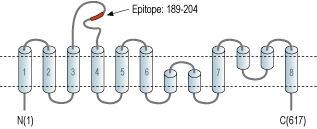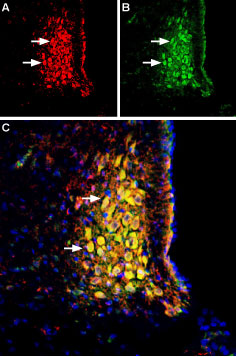Overview
- Peptide (C)KLLNASVLGDHTKYSK, corresponding to amino acid residues 189-204 of mouse NET (Accession O55192). 2nd extracellular loop.

 Western blot analysis of rat (lanes 1 and 3) and mouse (lanes 2 and 4) brain membranes:1,2. Anti-Noradrenaline Transporter (NET) (extracellular) Antibody (#AMT-002), (1:400).
Western blot analysis of rat (lanes 1 and 3) and mouse (lanes 2 and 4) brain membranes:1,2. Anti-Noradrenaline Transporter (NET) (extracellular) Antibody (#AMT-002), (1:400).
3,4. Anti-Noradrenaline Transporter (NET) (extracellular) Antibody, preincubated with Noradrenaline Transporter/NET (extracellular) Blocking Peptide (#BLP-MT002).
 Expression of Noradrenaline transporter (NET) in rat hippocampal dentate gyrusImmunohistochemical staining of immersion-fixed, free floating rat brain frozen sections using Anti-Noradrenaline Transporter (NET) (extracellular) Antibody (#AMT-002), (1:200). A. NET (green) is visualized in axonal processes (arrows) in the hilus. B. The relation to layers was explored using mouse anti-GAP43 (red). There are less axonal processes in the outer molecular layer (asterisk) compared to the inner molecular layer (arrows). C. Overlay of A and B shows co-localization of NET and GAP43 in the outer molecular layer.
Expression of Noradrenaline transporter (NET) in rat hippocampal dentate gyrusImmunohistochemical staining of immersion-fixed, free floating rat brain frozen sections using Anti-Noradrenaline Transporter (NET) (extracellular) Antibody (#AMT-002), (1:200). A. NET (green) is visualized in axonal processes (arrows) in the hilus. B. The relation to layers was explored using mouse anti-GAP43 (red). There are less axonal processes in the outer molecular layer (asterisk) compared to the inner molecular layer (arrows). C. Overlay of A and B shows co-localization of NET and GAP43 in the outer molecular layer.
 Expression of Noradrenaline transporter (NET) in live intact rat PC12 cellsCell surface detection of Noradrenaline transporter (NET) in live intact rat pheochromocytoma PC12 cells. Cells were stained with Anti-Noradrenaline Transporter (NET) (extracellular) Antibody (#AMT-002), (1:100), followed by goat anti-rabbit-AlexaFluor-594 secondary antibody (red). Cell nuclei (blue) were visualized using cell-permeable Hoechst 33342.
Expression of Noradrenaline transporter (NET) in live intact rat PC12 cellsCell surface detection of Noradrenaline transporter (NET) in live intact rat pheochromocytoma PC12 cells. Cells were stained with Anti-Noradrenaline Transporter (NET) (extracellular) Antibody (#AMT-002), (1:100), followed by goat anti-rabbit-AlexaFluor-594 secondary antibody (red). Cell nuclei (blue) were visualized using cell-permeable Hoechst 33342.
- Ramamoorthy, S. et al. (2010) Pharmacol. Ther. 129, 220.
- Siuta, M.A. et al. (2010) PLoS Biol. 8, e1000393.
- Madras, B.K. et al. (2005) Biol. Psychiatry 57, 1397.
- Gainetdinov, R.R. and Caron, M.G. (2003) Annu. Rev. Pharmacol. Toxicol. 43, 261.
- Moron, J.A. et al. (2002) J. Neurosci. 22, 389.
- Greengard, P. (2001) Science. 294, 1024.
- Kitayama, S. et al. (2001) Neurosci. Lett. 312, 108.
- Miller, G.W. et al. (1999) Trends. Pharmacol. Sci. 20, 424.
- Giros, B. et al. (1993) Trends. Pharmacol. Sci. 14, 43.
- Carlsson, A. (1987) Annu. Rev. Neurosci. 10, 19.
Many physiological, endocrine and behavioral functions are determined and regulated by monoamine signaling1,2. Many brain disorders such as depression, drug abuse, schizophrenia, attention deficit hyperactivity disorder (ADHD) are caused by the malfunction of monoaminergic transmission1-3. The intensity of monoaminergic signaling is determined by the availability of the monoamine, which is in turn determined in part by its uptake from the extracellular milieu via monoamine transporters. These transporters include DAT, SERT, and NET, responsible for uptaking dopamine, serotonin and noradrenaline respectively, and recycling them back for release3-5.
While the activity of each transporter is faithful to its neurotransmitter, NET has been shown to clear dopamine in DAT deprived or low DAT regions such as the brain cortex6-8.
DAT, SERT and NET are members of the Na+/Cl- dependent membrane transporter family which also includes other members. These transporters consist of 12 transmembrane domains and intracellular N- and C-termini. NET also has a significant extracellular loop between transmembrane regions three and four, which contains various glycosylation sites9. Like its counterparts, NET’s intracellular N- and C-terminal domains are also subject to phosphorylation and protein-protein interactions important for modulating its activity and localization. In addition alternative splicing has also been shown to regulate NET’s expression and function10.
NET is specifically expressed on noradrenaline nerve terminals, and is also expressed in the periphery, such as adrenal glands and placenta. NET malfunction is largely associated with attention and mood, as well as various cardiovascular disorders. NET is also a target for psychostimulants such as cocaine and amphetamines which disrupt its function, thereby causing an increase of noradrenaline in synaptic clefts3,9.
Application key:
Species reactivity key:
Alomone Labs is pleased to offer a highly specific antibody directed against an epitope of the mouse noradrenaline (norepinephrine) transporter. Anti-Noradrenaline Transporter (NET) (extracellular) Antibody (#AMT-002) can be used in western blot immunohistochemistry and immunocytochemistry applications. It has been designed to recognize NET from human, mouse and rat samples.
 Multiplex staining of Noradrenaline Transporter (NET) and Neurokinin 1 Receptor (NK1R) in rat brain stem.Immunohistochemical staining of perfusion-fixed frozen rat brain sections using Anti-Noradrenaline Transporter (NET) (extracellular) Antibody (#AMT-002), (1:400) and Anti-Neurokinin 1 Receptor (NK1R) (extracellular)-ATTO Fluor-488 Antibody (#ATR-001-AG), (1:80). A. NET staining (red) in section of rat locus coeruleus. B. NK1 receptor staining (green) in same section. C. Merge of the two images reveals several cells expressing both NET and NK1 receptor (arrows). Cell nuclei are stained with DAPI (blue).
Multiplex staining of Noradrenaline Transporter (NET) and Neurokinin 1 Receptor (NK1R) in rat brain stem.Immunohistochemical staining of perfusion-fixed frozen rat brain sections using Anti-Noradrenaline Transporter (NET) (extracellular) Antibody (#AMT-002), (1:400) and Anti-Neurokinin 1 Receptor (NK1R) (extracellular)-ATTO Fluor-488 Antibody (#ATR-001-AG), (1:80). A. NET staining (red) in section of rat locus coeruleus. B. NK1 receptor staining (green) in same section. C. Merge of the two images reveals several cells expressing both NET and NK1 receptor (arrows). Cell nuclei are stained with DAPI (blue).
Applications
Citations
- Rat basolateral amygdala lysate (1:500).
Karkhanis, A.N. et al. (2015) Synapse 69, 385.
- Mouse brain sections.
Gao, H. et al. (2018) Cancer Lett. 439, 91.
- Mouse brain sections.
Gao, H. et al. (2018) Cancer Lett. 439, 91.
